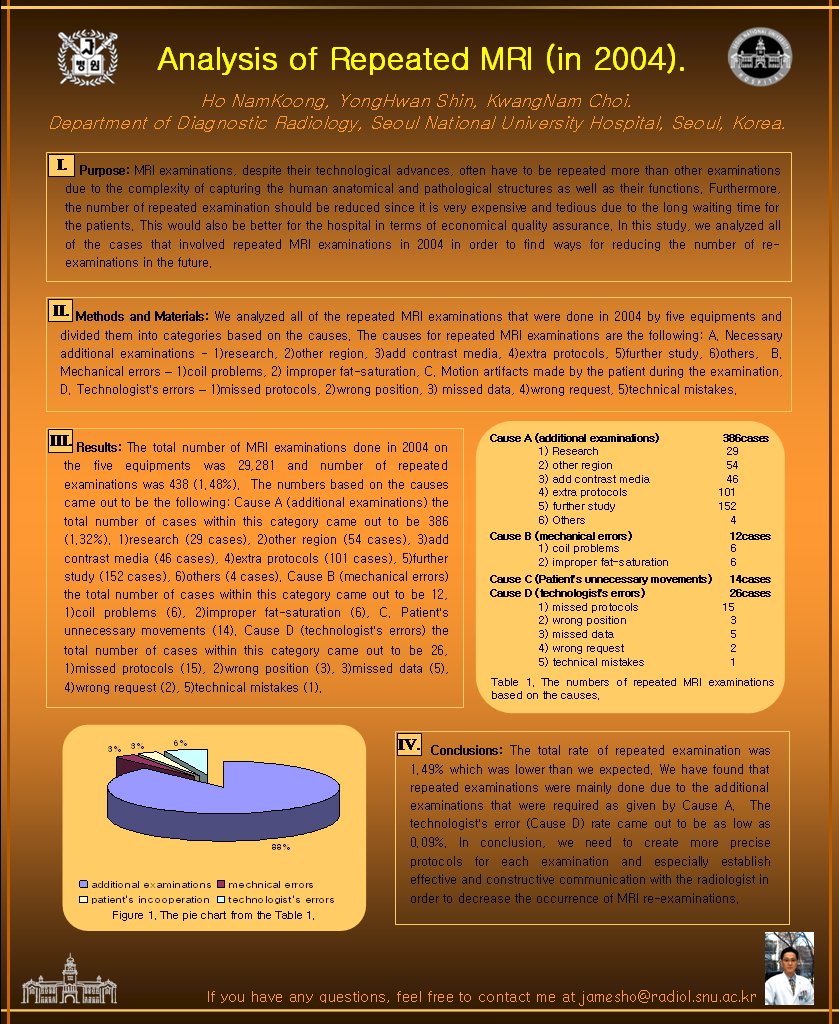2008. 8. 2. 14:59ㆍJames/Papers
Analysis of Repeated MRI (in 2004).
Ho NamKoong, YongHwan Shin, KwangNam Choi.
Department of Diagnostic Radiology,
I. Purpose: MRI examinations, despite their technological advances, often have to be repeated more than other examinations due to the complexity of capturing the human anatomical and pathological structures as well as their functions. Furthermore, the number of repeated examination should be reduced since it is very expensive and tedious due to the long waiting time for the patients. This would also be better for the hospital in terms of economical quality assurance. In this study, we analyzed all of the cases that involved repeated MRI examinations in 2004 in order to find ways for reducing the number of re-examinations in the future.
II. Methods and Materials: We analyzed all of the repeated MRI examinations that were done in 2004 by five equipments and divided them into categories based on the causes. The causes for repeated MRI examinations are the following: A. Necessary additional examinations - 1)research, 2)other region, 3)add contrast media, 4)extra protocols, 5)further study, 6)others, B. Mechanical errors – 1)coil problems, 2) improper fat-saturation, C. Motion artifacts made by the patient during the examination, D. Technologist’s errors – 1)missed protocols, 2)wrong position, 3) missed data, 4)wrong request, 5)technical mistakes.
III. Results: The total number of MRI examinations done in 2004 on the five equipments was 29,281 and number of repeated examinations was 438 (1.48%). The numbers based on the causes came out to be the following: Cause A (additional examinations) the total number of cases within this category came out to be 386 (1.32%). 1)research (29 cases), 2)other region (54 cases), 3)add contrast media (46 cases), 4)extra protocols (101 cases), 5)further study (152 cases), 6)others (4 cases). Cause B (mechanical errors) the total number of cases within this category came out to be 12, 1)coil problems (6), 2)improper fat-saturation (6), C. Patient’s unnecessary movements (14). Cause D (technologist’s errors) the total number of cases within this category came out to be 26, 1)missed protocols (15), 2)wrong position (3), 3)missed data (5), 4)wrong request (2), 5)technical mistakes (1).
IV. Conclusions: The total rate of repeated examination was 1.49% which was lower than we expected. We have found that repeated examinations were mainly done due to the additional examinations that were required as given by Cause A. The technologist’s error (Cause D) rate came out to be as low as 0.09%. In conclusion, we need to create more precise protocols for each examination and especially establish effective and constructive communication with the radiologist in order to decrease the occurrence of MRI re-examinations.
